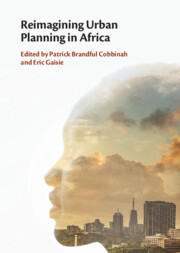Book contents
- Reimagining Urban Planning in Africa
- Reimagining Urban Planning in Africa
- Copyright page
- Contents
- Contributors
- Foreword
- Preface
- Acknowledgements
- Abbreviations
- Part I Understanding Sustainable Urban Planning in Africa
- 1 Reimagining African Cities
- 2 Annals of Urban Planning in Africa
- 3 New Cities in Africa and the Reimagination of Urban Planning
- 4 Informal Settlements and Pro-poor Urban Planning in African Cities
- 5 Urban Planning and Sustainable Land Governance in Africa
- 6 Urban Planning and Climate Change Action in Africa
- Part II Case Studies on Urban Planning in African Countries
- Part III Sustainable Urban Planning in Africa
- Index
- References
1 - Reimagining African Cities
from Part I - Understanding Sustainable Urban Planning in Africa
Published online by Cambridge University Press: 07 December 2023
- Reimagining Urban Planning in Africa
- Reimagining Urban Planning in Africa
- Copyright page
- Contents
- Contributors
- Foreword
- Preface
- Acknowledgements
- Abbreviations
- Part I Understanding Sustainable Urban Planning in Africa
- 1 Reimagining African Cities
- 2 Annals of Urban Planning in Africa
- 3 New Cities in Africa and the Reimagination of Urban Planning
- 4 Informal Settlements and Pro-poor Urban Planning in African Cities
- 5 Urban Planning and Sustainable Land Governance in Africa
- 6 Urban Planning and Climate Change Action in Africa
- Part II Case Studies on Urban Planning in African Countries
- Part III Sustainable Urban Planning in Africa
- Index
- References
Summary
This collection of essays is one in a series of books on urban planning and sustainable development in Africa, bringing together scholarship from different disciplines in urban studies, planning and social sciences across different regions of the continent. It is aimed at readers from urban specialisms in spatial planning, human geography, environmental law and other social sciences, and professionals and policymakers concerned with urban development, land use planning and informality governance. Urban planning has emerged over the past half a century in Africa through colonisation, influencing urban policies, practices, discourses and institutions in the continent’s cities. Today, it remains the bedrock for realising sustainable development ideals across the continent’s growing cities, yet current practices indicate otherwise. A narrative is presented on why urban planning needs to be reimagined in Africa and its association with sustainable urban development, involving complex policy developments during colonial and post-colonial times. The case of African cities is discussed, having acquired importance because of their particular history of colonisation and growth in urbanisation and population as well as experiences of climate change. The chapter contributions in this book are then outlined together with how they contribute to evolving ideas on urban planning and sustainable development in Africa.
- Type
- Chapter
- Information
- Reimagining Urban Planning in Africa , pp. 3 - 17Publisher: Cambridge University PressPrint publication year: 2023

